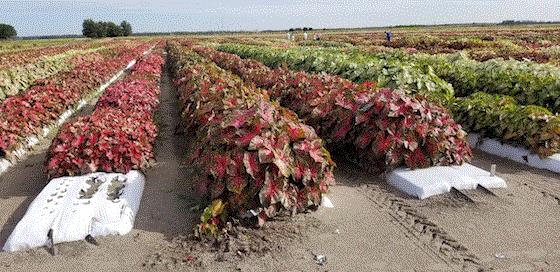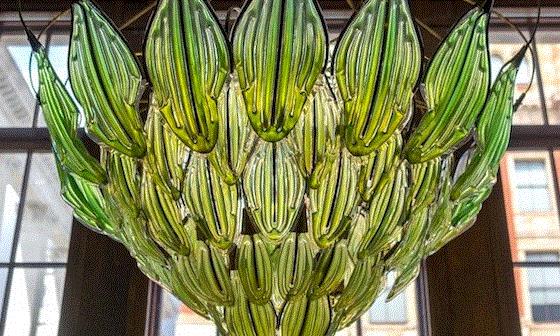Changing Caladium Culture
I had a real nice conversation with Richard Hollander and Nelson Darden of Classic Caladiums last week. You’ll remember that last year’s Hurricane Irma did a lot of damage to Florida’s caladium fields, which resulted in a severe shortage of bulbs. It also negatively impacted this year’s projected availability as less acreage was planted following the hurricane. “There are two ways to look at it,” Richard said, referring to Florida’s weather issues. “You can cry about it or get on with it.” Which is exactly what they did. They decided to change up their techniques in order to hedge their bets against potential weather issues this year.
You could say they pulled off a caladium culture coup earlier this spring by completely planting their caladium crop six weeks earlier than normal. Rather than planting in April, as has always been the norm, Classic Caladiums’ fields were planted in March. This gave the crop a head start in growth—which turned out to be just the trick to get the caladiums through the washout rains of early May. Planting in March is a bit risky due to cold weather, they explained. But as long as the soil temperatures are above 65F, the crop should be fine.
Two other techniques that helped prevent bulbs from washing away in May and June’s pouring rains were planting in laser-leveled fields and planting in raised beds under plastic mulch. If you’ve seen those large commercial strawberry fields out in California, that’s essentially how Classic planted their caladiums. And it wasn’t cheap! They planted the entire crop using an H-2A guest worker labor force, costing them about 50% more in planting labor. They hope the yield will increase over years past, barring any weather-related issues.

It turns out that by going “all in,” as Richard calls it, Classic produced the best crop they’ve had in their 18 years of growing caladiums. While it was a big risk to try something new, their farm manager called the new process a no-brainer. It’s not just them who are saying the crop looks awesome. They recently had visits by some Ball sales team members, a Disney World landscape team and many other plant professionals, all of whom were seriously impressed with what they saw.
Nelson was quick to point out that Classic has more than 60 new varieties, which exhibit many grower, and ultimately consumer, benefits. Such things as disease resistance, improved habit and reduced pot crop time have been bred into many of their newly-released varieties. One area getting a lot of attention is new caladium varieties that take full sun!
A planting bed filled with strapleaf caladiums.
I asked if they really wanted to let the cat out of the bag and tell folks their secret to success. “We’re proud of what we’re bringing to the table,” Richard said. “It’s the right step for the consumer.”

Bougainvillea Follow-Up
I wanted to dish out a couple more bits of bougainvillea culture tips as a follow-up to Jerome O’Neill’s info in the last Tropical Topics. I’d wanted to know how long bougainvilleas stayed in bloom once all the cultural conditions were right. “Bougainvilleas will continue to bloom during their flowering cycle, or season,” Jerome said in response to my question. “During this time, new bracts are formed on the growing tips and some older bracts will slowly be dropped.”
Jerome said that while little to nothing is written on this culturally, he believes that extending the conditions that bring about flowering (high light, a dry/damp watering regime and low nitrogen) does extend the length of time that bougainvilleas flower. They do eventually stop blooming, however, and when that happens, they start back up with their vegetative cycle.
For Hawaiians such as professor emeritus Richard Criley, bougies (as he calls them) flower nearly all year round, with their best blooming period happening between April and June. Richard reminded me that bougainvilleas flower on new wood, so pruning is necessary to get that new wood. Along with pruning, keep nitrogen down to prevent long and vigorous branching and you’ll be on track for a good crop—or a lovely blooming hedge.

Lacey Act Errors
Do you do a lot of plant importing? If so, make sure you have all your ducks (or the plant equivalent) in a row when you’re filling out the paperwork. Apparently, there have been so many errors made by importers and customs brokers in their submitted Lacey Act declarations that the Animal and Plant Health Inspection Service (APHIS) will start notifying folks of the faulty forms.
APHIS is the organization responsible for enforcing the Lacey Act, which requires folks who are importing certain plants to declare those plants’ scientific name, value, quantity and country of harvest. What’s commonly crossing APHIS’s desks are submissions misidentifying plants and listing odd plant/species pairings, along with the more common incomplete form and late submissions.
If you’ve submitted something that pulls a red flag on their end, APHIS will more than likely email you about it. Don’t just delete the email thinking it’s spam. Read what you may be submitting incorrectly and be sure to fix it going forward. Better that than risking continued errors and the possibility of being investigated, right?
And read up on what you’re supposed to be doing regarding Lacey Act declarations on the APHIS website. A little reading and understanding now may save you headaches later on down the road! Thanks to FNGLA for bringing this concern to our attention!
Two Trends to Watch
Speaking of FNGLA, I keep thinking back to last January’s TPIE and how valuable the presentation was from keynote speaker Max Luthy of Trendwatching.com. The trendspotting organization is coming out with a handful of new trends to track for 2019, and I contacted Max to see if I could get a sneak peek of a few to share with my audience. He gave me two:
Sentient Spaces. Max describes this as “a personalization of the physical world.” One example of this that Max gave me is a Sao Paulo subway that has doors with screens that provide customer information and advertisements. The doors can also scan the crowd’s facial expressions to gauge sex, age and reactions to the ads. The subway company can then use that information to pitch to potential advertisers.
Lab Rats. Wellness and well-being are trends we’ve seen for a while, but according to Max, wellness is headed toward “extremes of self-experimentation, testing, dosing” and much more. I think this trend is the one that most applies to our industry. Consumers are more and more interested in controlling their environments and nutrition in the “quest for the optimal version of themselves.” Plants can help!
Are these immediately applicable for us? Maybe not in the next year or two, but it’s good to know what is coming down the pike.

Indoor Citrus?
How many of you grow or sell lemon/orange/kumquat trees for interior use? If you do, please reach out to me when you have a moment. I have a question or two. Drop me a line at ewells@ballpublishing.com, if you’d be so kind. Thank you!
Finally …
Are algae the next trending air-cleansing houseplant? According to MyModernMet.com, a designer is harnessing the power of algae to not only clean the air but also to illuminate spaces.
Designer and biotechnologist Julian Melchiorri has created a “living” chandelier that consists of 70 glass leaves filled with green algae, which absorb carbon dioxide and release oxygen.

My question is this: If the algae are enclosed in glass, how do they have contact with the air to do their purifying business? But hey, it sure is pretty.
Comments, questions or news to share? Just drop me a line at ewells@ballpublishing.com.

Ellen Wells
Editor-at-Large
Green Profit
This edition of Tropical Topics was sent to 27,066 loyal readers!
If you're interested in advertising on Tropical Topics, contact Kim Brown ASAP!